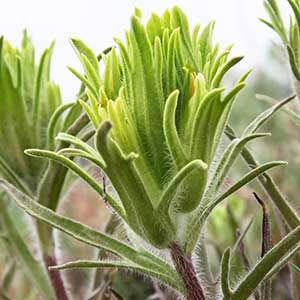Castilleja thompsonii
Castilleja oresbia
Thompson's Indian paintbrush, Thompson's owl clover, Thompson's paintbrush
pale paintbrush, pale Wallowa Indian paintbrush, pale Wallowa paintbrush
few to many, erect or ascending, unbranched or branched, hairs spreading, long, stiff, sometimes soft (especially in higher elevations), eglandular, mixed with shorter stipitate-glandular ones.
few to several, erect or ascending, sometimes decumbent at base, unbranched or branched, hairs usually retrorse, medium length, ± soft, eglandular, mixed with very short-glandular ones, sometimes with spreading, long, soft ones.
green to purple or reddish brown, linear to narrowly oblong or linear-lanceolate, 1.4–7.4 cm, not fleshy, margins plane to ± wavy, involute or flat, 3(–7)-lobed, apex acuminate;
lobes spreading-ascending, linear, short to long moving up leaf axis, apex acute or obtuse.
green to purple, linear to lanceolate, 2–7 cm, not fleshy, margins plane, involute, 3–5(–7)-lobed, apex acuminate to acute;
lobes spreading, linear to sometimes narrowly lanceolate, apex acute.
2.5–14 × 1–4 cm;
bracts greenish to pale yellow or reddish brown throughout, or proximally greenish to dull reddish purple, or ruddy brown, distally greenish to yellow-green or yellow, often aging dull reddish to dull purplish, lanceolate to oblong to ovate, 3–5(–9)-lobed;
lobes spreading to ascending, linear to narrowly lanceolate, long, proximal lobes arising below mid length, apex acute to obtuse.
2.5–18 × 1–3.5 cm;
bracts pale green to yellow-green or pale, dull reddish brown throughout, or proximally so colored but changing gradually to cream or yellowish on distal margins, narrowly to broadly lanceolate, (3–)5–7(–9)-lobed;
lobes ascending, linear, long, proximal lobes arising below mid length, central lobe apex obtuse, others acute.
straight, 18–21 mm;
tube 11–16 mm; subequal to calyx, sometimes beak exserted;
beak adaxially green, 5–7(–8) mm;
abaxial lip white, often proximally reddish, prominent, scarcely expanded, ± cylindric, 2.5–4(–5) mm, 50–70% as long as beak, glabrous or obscurely puberulent;
teeth incurved to erect, white, 2.5 mm.
straight, 21–36 mm;
tube 16–20 mm;
teeth of abaxial lip often exserted, beak exserted;
beak adaxially green, 4.2–5.5 mm;
abaxial lip green to purple, distally white, conspicuous, slightly but noticeably pouched, often visible through front cleft, 3–5 mm, 67–100% as long as beak, puberulent;
teeth erect, white, 1.8–2.1 mm.
colored as bracts, 12–25 mm;
abaxial and adaxial clefts 4–8 mm, 20–60% of calyx length, deeper than laterals, lateral (0–)1–3 mm, 7–25% of calyx length;
lobes linear, lanceolate, or triangular, apex acute, sometimes obtuse.
colored as bracts, 10–25 mm;
abaxial and adaxial clefts 6–7 mm, 30–60% of calyx length, deeper than laterals, lateral 5–10 mm, 40–50% of calyx length;
lobes linear, apex acute.
= 24, 48.
Castilleja thompsonii
Castilleja oresbia
Castilleja thompsonii is a characteristic species of the sagebrush communities on the eastern slope of the Cascade Range in Washington, and in the high deserts of the Columbia Basin. Historically, its range approached but apparently never entered Idaho in the Spokane River valley, but much of its habitat in that area is now converted to agriculture or suburban development or overwhelmed by non-native, invasive plants. Castilleja thompsonii occurs in a few sites in the Okanogan Valley region of southern British Columbia and at one site on the eastern slopes of the Cascade Range in Wasco County, Oregon. A distinctive form from the subalpine and alpine zones of Mt. Adams, in the southern Cascade Range of Washington, was named C. villicaulis. This form may merit varietal status under C. thompsonii. While both names were described in the same paper, C. thompsonii is the name used in all regional floras since their publication, after C. villicaulis was reduced to synonymy by M. Ownbey (1959).
(Discussion copyrighted by Flora of North America; reprinted with permission.)
Castilleja oresbia is endemic to eastern Oregon and adjacent Idaho. It is easily confused with both varieties of C. pallescens, which also occur in sagebrush habitats. Castilleja oresbia has longer calyx lobes and softer pubescence than C. pallescens var. pallescens, although some transitional specimens are found. Castilleja oresbia has a combination of longer calyx lobes, longer pubescence, and obscurely nerved bracts, which usually serve to separate it from C. pallescens var. inverta. All three have different, though somewhat overlapping, ranges. Castilleja oresbia occasionally hybridizes with C. peckiana in Grant County, Oregon.
(Discussion copyrighted by Flora of North America; reprinted with permission.)


